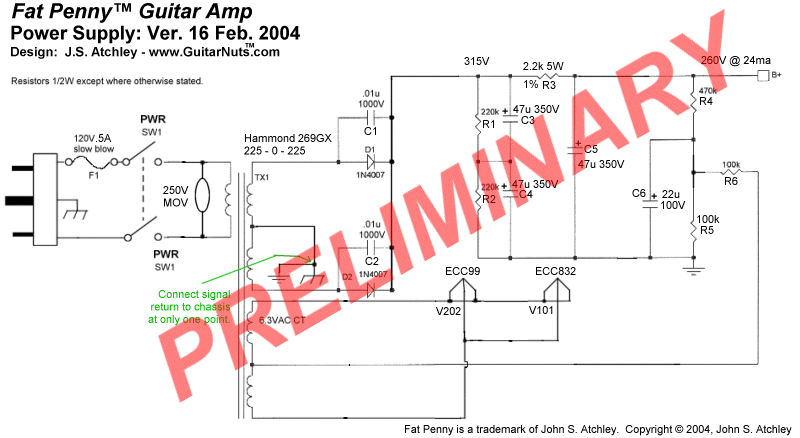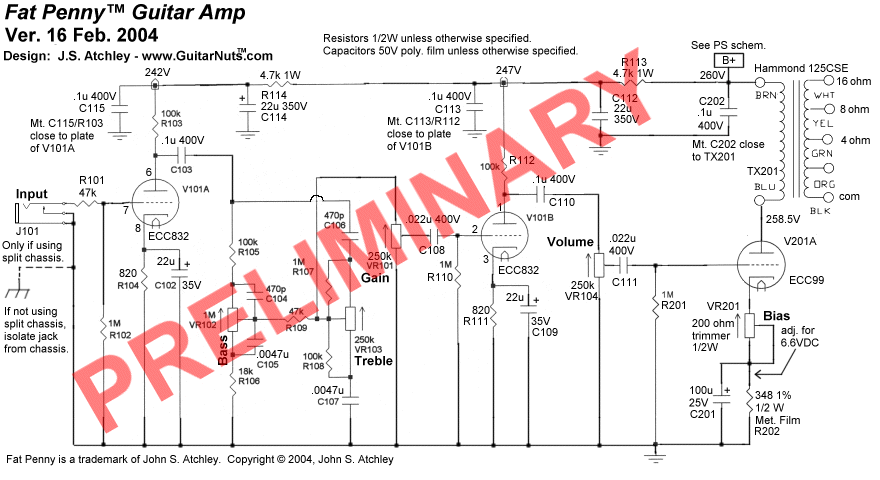The Fat Penny™
GuitarNuts™ 1-Watt Tube Guitar Amp |
Last Updated 16 Feb, 2004 |
While working on the design for a small full-featured
stereo guitar amp I stumbled across the ECC99 tube and decided
that, if it will break up sweetly, it is about perfect for the power output. I decided to build a small
"no frills" amp using the tube to test it before committing with the larger design.
I decided to document the project here because there are probably at least one or two other people who are interested
in such an amp. If you are qualified, you're welcome to build one for yourself, but please keep in mind that
right now the schematics have to be considered preliminary because I haven't yet prototyped the amp and I fully
expect that some tweaking of coupling and cathode capacitors will be required to optimize the tone once the first
amp is working.
Design goals. The tube is of no use to me in my larger project unless I can demonstrate
that it can offer a wide range of operation from clean through "just getting fat" blues distortion. If it will also
do "metal" that's fine, but it's not part of the goal. Obviously, the whole point of building a small
amp is to get power-tube overdrive at reasonable volume levels. Nonetheless, an amplifier without a reasonable
amount of headroom is a one trick pony - and I have no use for a one-trick pony no matter how good the trick!
 |
 |
CAUTION! Working on tube amplifiers can be extremely dangerous!
Do not attempt this project unless you have been trained to work safely with high voltages. This
project works with AC line voltages and with DC voltages approaching 400 volts - either of which is easily lethal!
Even if you do not get shocked while working on the project, if you do not build it correctly you or someone
else can be electrocuted later when simply using the amp. Even if no one is ever injured, an improperly
built amplifier can cause a fire that burns down your home.
If it sounds like I'm trying to scare you it's because I am. This project is intended only for
those who are qualified to accomplish it safely. For the rest of you, the best amp in the world isn't worth
killing yourself over!
Use at your own risk!
|  |
 |
Like the honkin' big red overlays say, these are preliminary schematics!


The preamplifier uses an unequal dual triode -- an ECC832 (12DW7) which is currently in production by JJ Tubes in
Slovakia. Spice simulation indicates the preamp will also work pretty well with a 12AT7 so if the ECC832
goes out of production it's not a major problem. Why an unequal triode? Well, I want enough gain in the
first stage that it can be pushed into clipping with a Tube Screamer™ or similar when desired but that much gain in
the second stage was just wasteful. A 12AT7 gives about the right amount of total gain through the two
stages but takes more drive to push the first stage into clipping. The unequal triode looks to be almost
ideal.
The tone stack is a Baxandall, with values borrowed from Duncan's Amp Pages. I ran a Spice simulation on this
circuit and this stack, while not working its best with the relatively high input impedance found here, still
outperforms a typical Marshall 3-band stack.
I don't have a Spice model for the ECC99 (if anybody does, please contact me) so I had to draw some loadlines.
The first one I drew was at 10k, 250V, and 19ma and after a few hours playing with other impedances and bias points
none looked as good so that's what I'm going with.
Note that if the ECC99 should go out of production, using both halves of a 12AU7 and a 10k load line looks decent
on paper, though the cathode resistor will have to be changed and clean power output will only be about 1/3 to 1/2 of a watt.
An old Danelectro Nifty-Fifty™ is so desparate to stop collecting dust in the corner that it has volunteered
its chassis as the guinea pig for this amp. The Nifty-Fifty amp was one I'd modified to run on gel cell batteries a
couple of years ago and since I no longer have need of a battery operated amp it's been languishing neglected
and lonely.
The Nifty-Fifty is pretty short on real estate so I'm going to build the power supply into a small separate box
in the bottom of the amp. This "split chassis" will let me get the power transformer as far as possible from
the output transformer and preamp.
I'm probably using a little more filtering than absolutely necessary but my take on that is, "better too much than
too little." This is actually only about 1/2 to 1/3 the amount of filtering I plan for the fully-featured
amp to come.
I'm going to ask some of the guys over on the AX84™ forum to sanity-check this design and then I'll order
parts. Once I start building this I'll take lots of pictures. Once it's built and all the kinks worked
out I'll get one of my friends who plays better than I do – that's most any of them
 – to record some clips.
– to record some clips.
John
|